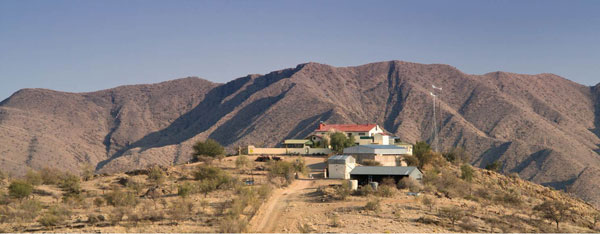S&T Contributing editor Govert Schilling explores two unique astronomical sites that lie under the dark skies of Namibia.
It's one of the strangest things I've ever seen. All around me is a flat area of loose rocks and small, thorny vegetation. But there's no horizon. No endless plains, no distant mountains. The scene suddenly stops at a distance of a few hundred meters. Beyond and above is just blue sky, with a burning hot Sun. I feel like I'm on a mini-planet.

The flat, rocky summit of Namibia's Gamsberg.
Govert Schilling
"Pretty weird, isn't it?" says Waltraub Eppelmann. We're at the center of the flat summit of Gamsberg, at 2,347 meters the third-highest mountain in Namibia (a former German colony). Waltraub drove me up here in her 4WD Toyota Landcruiser. It was a two-hour spine-chilling trip on the worst "road" I've ever been on, basically a jumble of large rocks and boulders, with fathomless abysses and grades up to almost 45°.

The road to Gamsberg.
Namibia Tourism Board
From the incredibly steep edge of the plateau, which measures some 1,000 by 800 meters, the view across the Hakos mountain range and the Khomas highland is spectacular. I try to imagine how Gamsberg will look like a few years from now, when construction of the Africa Millimetre Telescope (AMT) may have started.
A team led by Heino Falcke (Radboud University, The Netherlands), has recently signed an agreement with the University of Namibia to start developing the 15-meter single-dish AMT on the "mini-planet" summit of Gamsberg.
The main goal of the AMT is to take part in the international Event Horizon Telescope experiment — a network of millimeter-wave radio dishes around the world that should soon be able to image the supermassive black hole in the center of our Milky Way galaxy. Preferably, Falcke explains, the individual telescopes would be distributed evenly across the globe, "and there's a big hole on the map in Africa."
That’s still largely in the future. Right now, the Gamsberg only holds a slender telecommunications tower and a few small buildings operated by the International Amateur Observatory. "Things will change," says Waltraub Eppelmann. For one, the drive to the plateau will no longer be an adrenalin-producing tourist attraction once the AMT project constructs a proper access road to the summit.
From Farm to Observatory

The Hakos Guestfarm welcomes amateur astronomers to one of the darkest sites in the world.
Hakos Guestfarm
Together with her husband Friedhelm Hund, Waltraub runs the nearby Hakos Guestfarm. In the early 1970s, her father Walter Straube, who died in 2015, offered his cattle farm as a base for astronomers from the Max Planck Institute for Astronomy in Heidelberg, Germany. In 1970, the institute had bought the Gamsberg summit with the goal of putting a 2.2-meter optical telescope there, but this telescope eventually ended up at the European La Silla Observatory in northern Chile, leaving Gamsberg undeveloped.
Nevertheless, the extremely clear and dark skies above this part of southern Africa attracted semi-professional amateur astronomers. Famous German astrophotographer Hans Vehrenberg — a lawyer by profession — built a small observatory at Straube's farm, and became like a second father to young Waltraub and her brother Siegfried. After Vehrenberg's death in 1991, Hakos turned into an astronomical oasis for adventurous travelers, with guest rooms, camp sites, great food, some nice telescopes, and magnificent skies.
Meanwhile, the dark skies of Namibia kept luring professional astronomers too. Just after the turn of the century, not far from the Hakos farm, the Max Planck Institute started construction of the High Energy Stereoscopic System (HESS), named in part to honor the Austrian physicist and Nobel laureate Victor Hess, who discovered cosmic rays in 1912. HESS can just be glimpsed from the 350-kilometer gravel road between Namibia's capital city, Windhoek, and the harbor town of Walvis Bay. The unique telescope array is providing a view into the energetic universe.

Overview of the HESS Observatory. The five "telescopes" are surrounded by lightning rods.
University of Heidelberg
Every clear and hour of the night, the HESS telescopes are on the lookout for brief flashes of Cherenkov radiation — an extremely faint, bluish glow generated when high-energy gamma-ray photons from deep space enter Earth's atmosphere. Each HESS reflector consists of hundreds of flat mirrors, concentrating the faint flashes on an array of sensitive photo detectors. Four 12-meter reflectors, each with 382 circular 60-centimeter mirrors, are arranged in a square with sides of 120 meters; a fifth 28-meter dish, with 875 hexagonal 90-centimeter mirrors, was added five years ago in the square's center.
The observatory has detected energetic outbursts from quasars and galactic pulsars, which released photons with incredible TeV (tera-electronvolt) energies. HESS has also studied gamma rays produced in particle acceleration processes occuring at supernova shock waves. Moreover, the instrument observed very high-energy gamma rays from the galactic center, the origin of which is still being debated. The HESS websitehighlights other science results over the past decade.
Uncertain Future

One of the four 12-meter "light bucket" telescopes of the HESS Observatory. The huge parabolic reflector consists of dozens of individual flat, circular mirrors.
Govert Schilling
As I tour the photogenic site, French and South African technicians are carrying out maintenance on the large camera of the 28-meter instrument.
“We were in the race to host the Southern-Hemisphere part of the future (much bigger) international Cherenkov Telescope Array,” says site manager Toni Hanke, “but this will now be constructed at the European Paranal Observatory in Chile.”
“I'm not really sure about the future of HESS,” he adds. “It would be sad to dismantle this pioneering observatory because of lack of funding."
Then again, with the development of the AMT nearby, Waltraub's Hakos Guestfarm may start to draw even more dedicated amateur astronomers. I, for one, surely hope to return here someday.
Quelle: Sky&Telescope
